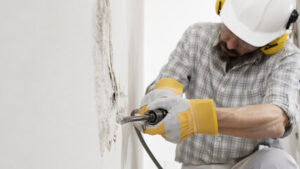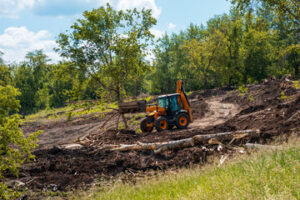The first step is to carefully inspect the stucco to determine if repair or remediation is required. This includes looking for moisture damage, musty odors and bubbling or blistering which may indicate an underlying issue that needs to be addressed.

The damaged area will be cleaned and a bonding agent applied to promote adhesion. Once this is dry, the crack will be filled with stucco patching material. For professional help, contact Stucco Repair Philadelphia PA.
The best way to prevent stucco cracks is through proper installation techniques. Ensure that the contractor mixes and applies stucco correctly, and that it cures as per instructions. A thorough home inspection can also help you identify potential issues before they arise.
Stucco is a durable siding option for homes and commercial buildings. However, it is not ideal for regions that experience heavy rains and snowstorms. Water absorbed into the stucco can cause problems, including the growth of mold and mildew. In addition to a decrease in aesthetic value, mold can deteriorate the structural integrity of your home and pose health risks for you and your family.
If you notice moisture damage to your stucco, call a professional right away. Stucco repair should always include waterproofing and sealing, to stop moisture intrusion. Cracks and gaps should be filled, and the surface should be thoroughly cleaned to ensure a long-lasting, durable finish.
Cracks are one of the most common signs of moisture damage in stucco. While not all cracks are a cause for concern, any that are wider than a hairline should be addressed by a professional as soon as possible. Stucco cracks can occur for a variety of reasons, including severe weather impacts, foundational shifting and improper installation.
Depending on the type of crack, there are several different ways to treat them. If the crack is cosmetic in nature, a recoat may be sufficient. Larger cracks that are causing structural problems should be repaired by a professional using an elastomeric crack filler.
Gaps and cracks around windows and other openings in the wall should be treated with a high-quality caulking product designed for use with stucco. The cracks should be thoroughly cleaned to remove any debris and dirt that could interfere with the bonding process. The caulk should be applied to the crack and then smoothed and textured to blend in with the surrounding stucco.
Stucco crack repair should be performed by a qualified contractor to ensure that the results are durable and attractive. Cracks that are not repaired properly can reappear, indicating a deeper issue that needs to be addressed.
Stains and Colors
The most common stains in stucco come from dirt and dust that get trapped in the porous and textured surface. Regular cleaning with a mild detergent can remove this grime and prevent the growth of mildew. Other stains can be caused by water, rust and even algae. Stucco repair experts can address these stains and protect the surface from further damage by using a combination of techniques.
Water stains on stucco are often caused by water penetration into the wall and evaporation. Adding water-resistant coatings to your stucco can help keep it looking like new. Moisture resistance also helps reduce mold growth and other structural problems.
Rust staining can occur when metal fixtures such as nails or window frames oxidize and bleed on the surface of the stucco. Keeping the stucco properly maintained and choosing materials that resist rust will minimize this problem.
Other types of stains can be caused by dirt or minerals that get caught in the stucco’s texture. These stains are usually a darker color and can be removed with a detergent and a scrub brush. Stucco repair specialists can apply a stain-repelling treatment to your home’s stucco that will help prevent future stains and keep the surface looking great.
Bleeding paint on a stucco wall is a sign of poor quality or improper installation. When painting over stucco, it is critical to allow enough time for the surface to dry before applying additional coats. Taking the time to do this correctly can ensure that the paint will adhere well to the surface and not chip or peel later on.
Stucco professionals know how to properly prepare a stucco surface for paint and can advise you on what color is best for your building. They will also know how many coats of paint are needed to achieve a uniform appearance that will stand up to the elements and your climate.
Integrated color stucco has the color mixed into the plaster, so it is less likely to fade or change over time. However, when the color does fade, it can cause discoloration and blotchy patches on the surface. It’s important to identify the source of these stains so that the appropriate repair can be made. A professional can use a borescope or core sample to visually inspect the layers beneath the surface, helping to detect hidden issues such as mold, mildew or other damage.
Sealing
Getting your stucco properly sealed can prevent moisture intrusion and significantly cut energy bills. Unsealed stucco often develops cracks and gaps that allow air to infiltrate or escape the home, which creates unnecessary stress on heating and cooling systems. A reputable stucco contractor can address these problems through meticulous sealing, ensuring an energy-efficient home and a healthy living environment for homeowners.
In order to ensure a comprehensive and effective seal, it’s important to use a high-quality primer designed for stucco applications. The primer should also be applied in a thick coat to ensure complete coverage. After the priming process, a high-quality, stucco-specific sealant should be used to fill in any cracks or gaps and provide an energy-efficient barrier against moisture infiltration.
The choice of sealant is crucial, as it will influence the performance of the entire application. A good sealant should have excellent adhesion, durability, and resistance to moisture and weathering. It’s essential to follow the manufacturer’s instructions for application to get the best results. A reputable stucco contractor will take the time to thoroughly inspect your walls before determining whether repair or remediation is necessary. They will examine how well the stucco is attached to the lath (the wooden slats that keep it attached to the wall’s framework), as this will help them determine if repair is truly an option.
As with any home improvement project, it’s important to stay within budget and schedule. A reputable stucco contractor will provide a fair estimate and work with you to ensure the job is completed on time and within your budget. They will also provide a warranty to give you peace of mind that the work they perform is of the highest quality.
To ensure that the stucco is in good shape and that it continues to perform as intended, a regular maintenance plan should be put in place. This should include regularly washing the stucco with a gentle detergent to remove dirt, dust, and debris that can affect the performance of the sealant. It’s also a good idea to have a professional inspect your stucco every year to spot potential problems early, so they can be fixed before they cause major damage.
Maintenance
Stucco is a durable material and can last for 100 years or more when properly maintained. However, like all exterior finishes it does require some periodic attention to keep it looking good. Small cracks and chips should be addressed promptly as they can worsen quickly if ignored. It is also important to inspect stucco for signs of moisture infiltration, such as discoloration and mold or mildew growth. Regular inspections and the use of a high-quality, breathable masonry sealant are key to maintaining your stucco.
Moisture infiltration can be caused by several issues, including improper caulking around windows and doors, weather changes, and settling of the house. Water intrusion can cause mold, wood rot, and buckling of the stucco. It is also important to check the integrity of gutters and downspouts to prevent clogs and ensure proper drainage. Keeping trees and plants away from stucco can also help to prevent damage.
A professional stucco contractor can evaluate and diagnose the underlying issues causing the moisture intrusion, and recommend a course of action to correct it. This can involve repairing cracks, or in more serious cases, replacing sections of the wall system. Stucco contractors can also repair or replace damaged window flashings, and make any necessary drywall repairs.
As with any home or commercial building, the best way to maintain your stucco is to perform routine maintenance, including inspections and cleaning. Stucco surfaces can be cleaned using a garden hose on a low setting or a power washer with a mixture of water and soap, or bleach and water. Stucco should be rinsed to ensure it is clean and free of debris.
If you are considering a do-it-yourself application of stucco, it is important to work with an experienced professional. A reputable company will provide you with the right mix of materials and tools, and offer expert advice to ensure that the application is successful. This can save you money in the long run by avoiding the potential for future costly repair or replacement. It is also important to hire a reputable business that is licensed, insured, and offers a guarantee on their work.
